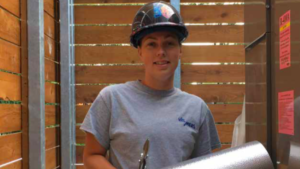
Geneveive Noel is a mechanical insulator at Val-mers isolation in Quebec. She has been in the industry about five years, including a year at trade school. She’d never heard of the mechanical insulation trade until she decided to go back to school as an adult and began researching various professions.
“I like the physical work, the salary, the benefits, and the school duration,” she says. “These were all things I was looking for.”
Noel is one of a growing number of women entering trades and finding rewarding, well-paying, lifestyle-friendly work they are proud of. Besides earning money while their friends spend thousands on university, some women are finding physical work, a technical mindset, and the camaraderie they find on a construction site are exactly what they need to check “ideal work satisfaction” off their bucket lists.
And it’s a good thing. Canada’s construction industry (all industries, actually) is facing a labour shortage and a retirement wave that is going to change the landscape of Canadian employment forever. For the first time in history the sheer number of retirees and the knowledge, skill, and work ethic they take with them will leave a new, demanding, but optimistic environment behind that will be ripe for innovation, hungry for technology, and wide-open for change—this is where the ability to recruit and retain women will become essential.
Recruiting women in construction has never been easy, but times are changing. The issue in most traditionally male-dominated sectors is simply too-small a labour pool. Manufacturing, for instance, is ripe with businesses actively looking to recruit women, but few apply, according to a report released earlier this year by the Canadian Manufacturers & Exporters. Although women occupy 48 percent of Canadian jobs, only 28 percent of manufacturing jobs are held by women, along with 4.5 percent of skilled trade jobs in general.
Another of the report’s important findings was a self- perpetuating cycle hinged on a distinct lack of mentorship for women. Essentially, because there are few women in the skilled trades, those interested in these fields are unable to find female mentors, or are turned away by the optics of being the only woman on site.
“The existing gender imbalance discourages women from considering a career in manufacturing,” said the CME report. “That creates a self-perpetuating cycle whereby women avoid manufacturing jobs because there are not enough women in manufacturing.”
According to Statistics Canada’s information on apprenticeship registrations, the gender gap is obvious—in 2015, 66 women signed up as machinists, along with 1,545 men. Fifty-four women entered sheet metal, compared with 1,476 men; and, 72 women registered as heavy duty mechanics, along with 2,520 men.
The call to governments is to reach girls sooner, introducing them to the STEM (science, technology, engineering, and math)fields sooner and with more gender-specific support. And support is coming.
Over the past five years, the government has introduced a number of programs and spending initiatives aimed at employment that could intrinsically address the gender gap. The federal government released a major infrastructure program in 2017, calling for $81.2 billion in spending over the next decade. Proposals, particularly those aimed at employment, will be run through gender-based analysis to determine how policies affect men and women differently, and will take into account other demographic and socioeconomic data such as age, income, and culture. Associations and unions are also working to change the optics of the every day jobsite.
Ashley Duncan is a Red Seal mechanical insulator from Vancouver. She worked for AARC West Mechanical Insulation for eight years, and in the last few years had been running jobs in a foreman position. She currently works in the Heat and Frost Local 118 union hall, assisting with the Sustainability Program, among other things.
Duncan entered the field on her father’s suggestion and found it was an immediate fit.“My dad is a plumber/pipefitter,and he’d been working side by side with AARC West,” she says. “He told me I should try it out and see if I like it. I went for it, and I loved it!”
Highlights of the job for her were doing something new every day and enjoying the people she worked with. “And I loved how I was always moving, since sitting still isn’t a strong skill of mine,” she says. “I’ve also always been very fortunate to have worked with great people, so I don’t have a lot of negative things to say about coming up in the trades. My company was amazing, and so is my union.”
When it comes to the day-to-day work, Noel enjoys the variety offered in mechanical insulation – “we are never doing the same thing every day, on and on,” she says – and best of all is the technical side and how the job looks when it is all finished.
“The biggest challenge, I think, in this job is to get to work with someone who wants to help you and can show you the tricks of the trade so you can develop a good work method,” she says. “I actually was lucky to have been paired with a good coworker who showed me a lot.”
Contractors are starting to see the value in hiring women and in equal opportunity, but this hasn’t always been the case.
Sandra Brynjolfson, mentorship co-ordinator for the BC Centre for Women in the Trades (BCCWITT) says that organization was formed to address the most common barriers women experience in entering trades.
An electrician by trade, Brynjolfson has been in the industry for two decades. When she started 20 years ago, there were no female mentors and few women on the job, and she experienced her share of harassment. Even today, her story is not unique—tales of bullying, of constantly being passed over for promotion, and of unwanted harassment are still common. “Just when I think we are seeing a change and things are getting better, another woman shares a heartbreaking story and leaves her trade,” says Brynjolfson. “The BC Centre for Women in The Trades is working hard to change this.”
The organization was formed as a two-year pilot project after the provincial government announced funding for women in the skilled trades, thanks to lobbying efforts from the BC Building Trades and tradeswomen. Its mandate is retention of women in the trades through outreach, networking, and training opportunities; support for employers and unions for recruitment and retention strategies; and workplace culture development using the Be More Than a Bystander program, which helps men facilitate a workplace culture where harassment is not tolerated.
An analysis was performed by the Social Research and Demonstration Corporation (SRDC) and many tradeswomen participated in focus groups throughout the province. Barriers for women include proper fitting safety gear, clean washroom facilities, lack of promotion, or even being hired.
Brynjolfson’s advice for contractors wanting to hire women would be to “make sure they have some good policies in place, like a bullying and harassment policy, make sure they use gender neutral language in all their forms, policies, and training and safety programs; and out and out just hire them!”
Duncan has a simple message for women out there thinking about getting into a trade, especially mechanical insulation: “Do it! I was a server for awhile, among a couple other jobs growing up, and out of all the jobs I’ve done, this is the most exciting, stable, well-paying career I’ve ever had.”
The positives are too many to mention, she says. “And it’s always cool driving past a project you worked on and thinking, ‘I helped build that!’ Overall, if you’re looking for a great career, mechanical insulation is the way to go,” says Duncan. “After all, pipes need jackets, too!”
Noel agrees, and encourages contractors to give women the same opportunities for education and advancement they would give anyone else. “I actually think women have naturally good skills for this kind of job,” she says. “And for women, I encourage them to keep focusing on the job and to never forget that if they are there, it is because they are doing a good job and deserve to be.”



